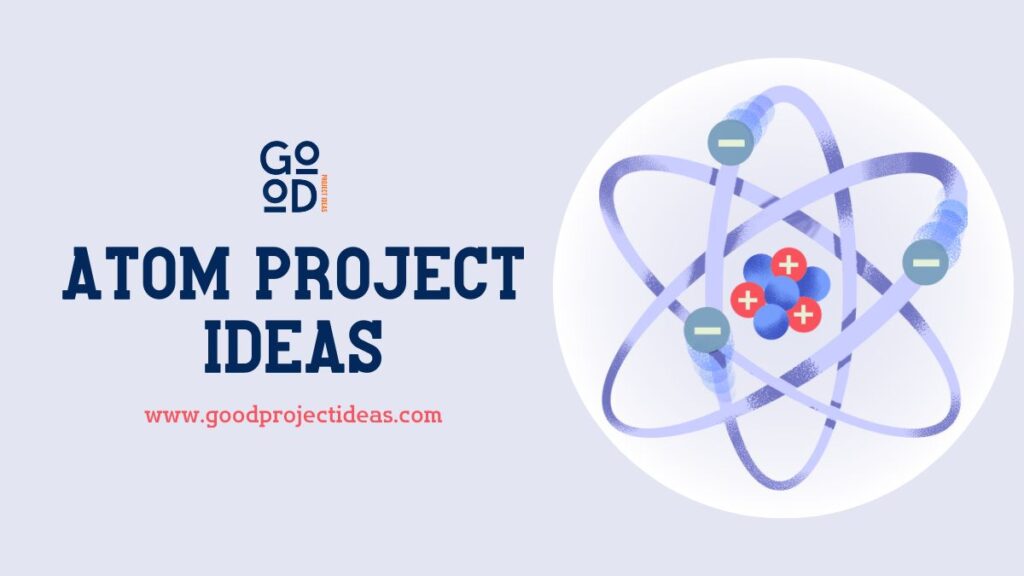Discover fun Atom Project Ideas to learn about atoms! From cool experiments to interesting presentations, find engaging ways to understand how matter is built. Start exploring the world of atoms today!
Let’s dive into the world of atoms! Here, you’ll find fun and interesting Atom Project Ideas to learn all about these tiny building blocks of everything around us. Ready to explore the mysteries of atoms with exciting experiments and cool projects? Let’s get started!
Introduction to Atom
Atoms are nature’s building blocks, making up everything around us. They’re super tiny – imagine millions of them lined up would only be as wide as a hair!
The Basics
- Atoms have a central part called the nucleus, made of even tinier bits called protons and neutrons.
- Protons are positive, neutrons are neutral, and electrons zip around the nucleus.
Why Electrons Matter
- Protons determine an atom’s element (like iron with 26 protons).
- Electrons make atoms interact and bond to form stuff.
Size and Scale
- Atoms are mostly empty space, with a dense nucleus and buzzing electrons.
Atom Project Ideas
Check out Atom project ideas:-
Chemistry
- Build a model of an atom.
- Create a timeline of atomic models.
- Investigate isotopes of an element.
- Explore electron orbitals with a model.
- Demonstrate electron cloud concept.
- Research famous chemists’ contributions.
- Create a comic strip on atomic structure.
- Design a board game about atoms.
- Experiment with atomic absorption spectroscopy.
- Study atoms in chemical reactions.
Physics
- Explore atoms in different states of matter.
- Demonstrate atoms in a magnetic field.
- Build a magnetic ball atom model.
- Research atomic bomb history.
- Explore atomic clocks and uses.
- Investigate atomic nuclei properties.
- Create an animation on atomic fusion.
- Study quantum tunneling in atoms.
- Investigate superheavy elements.
- Build a cloud chamber for atomic particles.
Biology
- Study atoms in biological molecules.
- Investigate radiation effects on organisms.
- Model atoms’ role in DNA.
- Research isotopes in medicine.
- Explore isotopic labeling.
- Study atomic mutations in organisms.
- Investigate atoms in photosynthesis.
- Research atomic imaging in biology.
- Explore atomic force microscopy.
- Study trace elements in biology.
Environmental Science
- Study atoms in air pollution.
- Investigate nuclear waste effects.
- Create a carbon cycle model.
- Research isotopes in environmental studies.
- Explore atomic energy in conservation.
- Study atoms in ocean acidification.
- Investigate atomic testing’s environmental impact.
- Research radioactive dating methods.
- Explore atomic absorption in analysis.
- Study atoms in soil composition.
Materials Science
- Investigate atoms in crystal formation.
- Study atomic structures in materials.
- Create a model of atomic bonding.
- Research nanotechnology and atomic manipulation.
- Explore atomic diffusion in materials.
- Investigate atomic defects’ effects.
- Study atoms in alloy formation.
- Create a video on atomic arrangement.
- Explore atomic layer deposition.
- Study atoms in semiconductor materials.
Astronomy
- Study atoms in stars.
- Investigate atomic spectra in astronomy.
- Create a model of atomic fusion in stars.
- Research stars’ life cycle based on atoms.
- Explore atomic clocks in space.
- Study atoms in galaxy formation.
- Investigate cosmic rays’ effects.
- Research exoplanet discovery using atoms.
- Explore atomic hydrogen in space.
- Study atoms in the Big Bang theory.
Engineering
- Investigate atoms in material strength.
- Study atomic vibrations’ effects.
- Create a crystal lattice model.
- Research atomic simulations in engineering.
- Explore atomic layer etching.
- Study atoms in heat conduction.
- Investigate atomic defects in materials.
- Research atomic-scale machining.
- Explore atomic layer deposition in fabrication.
- Study atoms in corrosion prevention.
Computer Science
- Investigate atoms in quantum computing.
- Study atomic operations in parallel computing.
- Create a model of atomic memory operations.
- Research atomic data structures.
- Explore atomic transactions in databases.
- Study atoms in encryption algorithms.
- Investigate atomic clocks in systems.
- Research atomicity in software development.
- Explore atomic operations in operating systems.
- Study atoms in error correction codes.
Education
- Create an atomic structure lesson plan.
- Develop a hands-on atomic models activity.
- Design a quiz on atomic theory history.
- Research misconceptions about atoms.
- Explore atomic simulations in teaching.
- Study atoms in STEM education.
- Investigate atomic illustrations in textbooks.
- Research atomic theory in different cultures.
- Explore atomic models in art and literature.
- Study atoms in scientific revolutions.
Art and Design
- Create art inspired by atomic structures.
- Design a logo for an atomic research institute.
- Illustrate atomic bonding in a graphic novel.
- Research atomic aesthetics in design.
- Explore atomic patterns in textile design.
- Study atoms in sculpture and architecture.
- Investigate atomic colors in visual arts.
- Research atomic motifs in jewelry design.
- Explore atomic shapes in pottery.
- Study atoms in art conservation.
History
- Research atomic theory development.
- Study ancient philosophers’ atomic ideas.
- Create a timeline of atomic science history.
- Investigate alchemy’s role in atomic theory.
- Explore atomic mythology in ancient cultures.
- Study atoms in the industrial revolution.
- Investigate atomic theory’s impact on philosophy.
- Research the atomic bomb’s historical impact.
- Explore atomic energy in the Cold War.
- Study atoms in shaping modern worldviews.
Health and Medicine
- Investigate atoms in human metabolism.
- Study atomic radiation effects.
- Model atomic interactions in drugs.
- Research isotopes in medical imaging.
- Explore atomic medicine applications.
- Study atoms in genetic diseases.
- Investigate atomic mutations’ health effects.
- Research atomic surgery techniques.
- Explore atomic imaging in diagnostics.
- Study trace elements in nutrition.
Music and Sound
- Create music inspired by atomic processes.
- Design a musical instrument based on atoms.
- Study atoms in sound production.
- Research atomic vibrations in music.
- Explore atomic rhythms in music theory.
- Study atomic resonance in acoustics.
- Investigate atoms in electronic music.
- Research atomic frequencies in sound engineering.
- Explore atomic harmonics in musical scales.
- Study atoms in the physics of singing.
Sports and Recreation
- Investigate atoms in sports equipment.
- Study atomic friction in sports performance.
- Model atomic interactions in ball sports.
- Research atomic materials in sports tech.
- Explore atomic energy in sports nutrition.
- Study atoms in the physics of movement.
- Investigate atomic vibrations’ effects on athletics.
- Research atomic simulations in sports science.
- Explore atomic muscle contractions in physiology.
- Study atoms in sports injury prevention.
Law and Ethics
- Research atomic weapons’ legal and ethical implications.
- Study atoms in international treaties.
- Create a model of atomic testing sites.
- Research atomic espionage consequences.
- Explore atomic diplomacy in history.
- Study atomic accidents’ policy effects.
- Investigate atoms in environmental law.
- Research atomic energy regulation.
- Explore atomic ethics in research.
- Study atoms in the ethics of warfare.
Mathematics
- Investigate atoms in mathematical models.
- Study atomic operations in math.
- Create a model of atomic patterns in numbers.
- Research atomic algorithms.
- Explore atomic equations in math.
- Study atoms in cryptography.
- Investigate atomic randomness in probability.
- Research atomic logic gates.
- Explore atomic geometry in math.
- Study atoms in the philosophy of math.
Psychology
- Research atoms in brain function.
- Study atomic neurotransmitters’ effects.
- Model atomic interactions in neural networks.
- Research isotopes in psychology.
- Explore atomic psychology applications.
- Study atoms in memory formation.
- Investigate atomic emotions’ effects on mental health.
- Research atomic therapy techniques.
- Explore atomic perception in psychology.
- Study atoms in cognitive development.
Sociology
- Investigate atoms in social structures.
- Study atomic interactions in group dynamics.
- Create a model of atomic relationships in society.
- Research isotopes in sociological research.
- Explore atomic communities’ development.
- Study atoms in cultural identity.
- Investigate atomic changes’ effects on social norms.
- Research atomic theory in social movements.
- Explore atomic networks in social media.
- Study atoms in the sociology of science.
Linguistics
- Research atoms in language evolution.
- Study atomic sound units in phonetics.
- Create a model of atomic language elements.
- Research isotopes in linguistic variation.
- Explore atomic grammar in linguistics.
- Study atoms in language acquisition.
- Investigate atomic metaphors in language.
- Research atomic languages and structures.
- Explore atomic semantics in linguistics.
- Study atoms in the philosophy of language.
Philosophy
- Investigate atoms in philosophical thought.
- Study atomic concepts in metaphysics.
- Create a model of atomic reality elements.
- Research atomic philosophy in cultures.
- Explore atomic ethics in philosophy.
- Study atoms in epistemology.
- Investigate atomic logic in reasoning.
- Research atomic aesthetics in art philosophy.
- Explore atomic meaning in language philosophy.
- Study atoms in the philosophy of science.
These concise ideas should make it easier to choose and implement a project that aligns with your interests and educational goals.
Atom Project Ideas for 7th Grade
Here are some fun and engaging project ideas for 7th graders to explore atoms:
Build Models
- Use household items like pipe cleaners or beads to make a 3D atom model.
- Create a digital atom model using software like Tinkercad.
Express Creativity
- Make a comic strip about an electron’s adventures in an atom.
- Design a poster or infographic showcasing interesting elements from the periodic table.
Interactive Activities
- Create a matching game with terms like “proton” and “neutron” for a fun way to learn.
- Play Atomic Bingo using elements, atomic numbers, or symbols.
Research Projects
- Explore the history of atomic theory and key scientists like Democritus and Bohr.
- Present a detailed report on a specific element’s properties and uses.
Remember to choose a project that interests you and explain your ideas clearly. Have fun exploring the world of atoms!
How to make atom model for school project?
Creating an engaging atom model for your school project is a fun way to learn about atomic structure! Here are two popular approaches using common materials:
3D Model with Balls and Sticks
- Materials: Cardboard or Styrofoam board (base), balls of different sizes and colors (protons, neutrons, electrons), pipe cleaners or sticks, glue.
- Steps:
- Create the nucleus by gluing red (protons) and blue (neutrons) balls together.
- Determine the number of electron shells for your element and cut pipe cleaners accordingly.
- Attach the pipe cleaners to the nucleus, increasing in length for outer shells.
- Attach white or yellow balls (electrons) to the pipe cleaners based on the electron count per shell.
Planetary Model with String and Beads
- Materials: Styrofoam ball (nucleus), paint (optional), string or fishing line, beads (for electrons), scissors, pen or marker.
- Steps:
- Paint the Styrofoam ball to represent the nucleus (optional).
- Mark circles on the ball at different distances to represent electron shells.
- Cut string into lengths corresponding to the electron shells.
- Thread beads onto the strings, varying the number for each shell.
- Tie the strings to the marked positions on the Styrofoam ball.
Tips
- Label your model with the element name and its atomic number.
- Include a key explaining the colors of the balls and their representation.
- Research your chosen element and add an information card detailing its properties and uses.
Feel free to add your own creative ideas to make your atom model unique and informative!
Conclusion
Got it, let’s keep it light and engaging! These atom projects are like your backstage pass to the world of science fun! Whether you’re a student, a teacher, or just someone who loves poking around to see how things tick, there’s something here that’ll make you go, “Whoa, that’s cool!”
Picture this: you could be building tiny models or mixing up potions in your own mini lab. It’s all about making science feel like a wild adventure! So, why not give one (or a few!) a whirl? You never know what awesome stuff you might stumble upon along the way!



